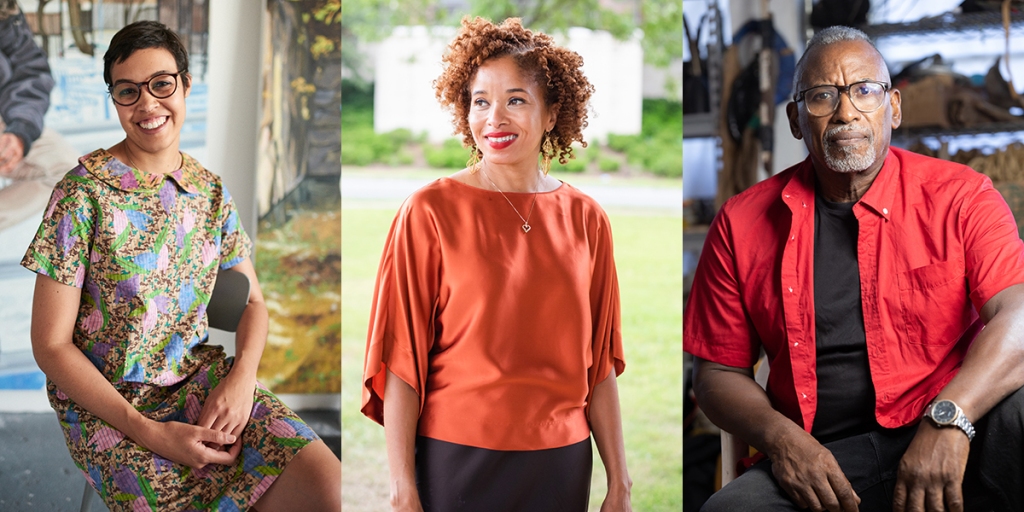 From left to right, artist Jordan Casteel, art historian Nicole Fleetwood, and artist Daniel Lind-Ramos. Courtesy MacArthur Foundation (3)
From left to right, artist Jordan Casteel, art historian Nicole Fleetwood, and artist Daniel Lind-Ramos. Courtesy MacArthur Foundation (3)
Painter Jordan Casteel, sculptor Daniel Lind-Ramos, and art historian Nicole Fleetwood were among the 2021 winners of the MacArthur Foundation’s “genius” fellowships, one of the most highly esteemed arts awards in the world. Each will receive $625,000 over the course of five years.
Though not limited to the art world, the MacArthur Foundation’s fellowships are considered a sign of the winners’ far-reaching influence in their respective field. Past fellows have included some of today’s most widely acclaimed artists, from Rick Lowe to Wu Tsang.
Casteel is best known for her intimate portraits of residents in Harlem, the New York neighborhood she has long called home. In placing a focus on Black and Brown sitters, she represents people whose images are not typically seen in art institutions, all while imbuing their pictures with deeply felt psychologies. In an interview with the New York Times last year, Studio Museum in Harlem director Thelma Golden praised Casteel for her ability “to capture a sense of spirit, a sense of self, a sense of soul.”
In 2020, Casteel was the subject of her biggest solo show to date, at the New Museum in New York, and the artist’s portrait of fashion designer Aurora James appeared on the cover of Vogue‘s vaunted September issue. Her work is set to appear in the survey “Black American Portraits” at the Los Angeles County Museum of Art in November.
Fleetwood organized the acclaimed 2020 MoMA PS1 exhibition “Marking Time: Art in the Age of Mass Incarceration,” which opened earlier this month at the University of Birmingham’s Abroms-Engel Institute for Visual Arts in Alabama. The subject of a related book of the same name published ahead of the exhibition by Harvard University Press, “Marking Time” surveys art made about and in response to mass incarceration in the U.S. It features art by former inmates, among them Tameca Cole, James “Yaya” Hough, and Jesse Krimes, as well as non-incarcerated creators like American Artist and Sable Elyse Smith.
In addition to illuminating forms of racism and exploitation that often go unseen, “Marking Time” also showed how visual art could act as a kind of protest within the carceral system. “It’s revolutionary to turn that experience into one of aesthetic engagement, creativity, something beyond the state’s management,” Fleetwood told ARTnews in 2020. The New York Times called the show one of the best exhibitions of 2020.
Lind-Ramos crafts sculptures from objects found in Loíza, the Puerto Rican town in which he is based. The artist once told Garage that his found materials “cause me to be inspired by an image or memory, they take me there.” Often resembling science-fictional beings, these works draw on Lind-Ramos’s life as a Black Puerto Rican man, as well as the history of Puerto Rico, with an eye toward colonialism and racism.
In 2019, he showed one of the most memorable works at the Whitney Biennial, a sculpture vaguely resembling the Virgin Mary—a pun intended to also recall the damage wrought by Hurricane Maria and the sluggish response to it by U.S. politicians. Last year, he received a $50,000 award from the Pérez Art Museum Miami. His work is currently on view at the Haus der Kunst in Munich.
Also among the winners this MacArthur winners this year were filmmakers Cristina Ibarra and Alex Rivera; Jacqueline Stewart, a film scholar and the chief artistic officer of the newly unveiled Academy Museum of Motion Pictures in Los Angeles; Ibram X. Kendi, whose book How to Be an Antiracist became a bestseller in 2020; and historian Keeanga-Yamahtta Taylor.
Source link : https://www.artnews.com/art-news/news/macarthur-genius-fellowships-2021-jordan-casteel-nicole-fleetwood-daniel-lind-ramos-1234605120












